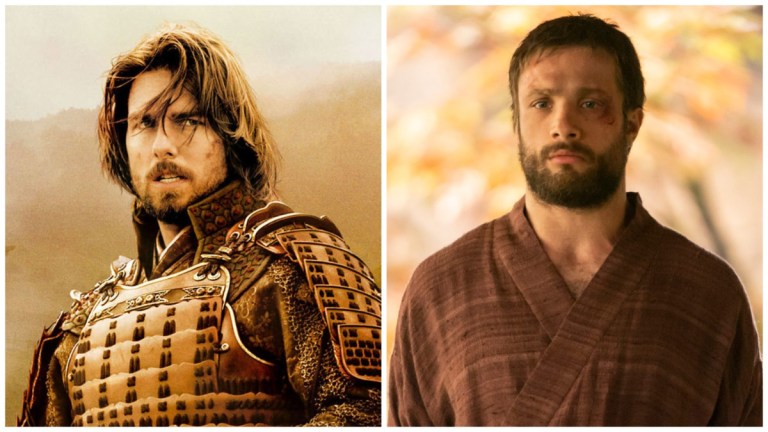The Last Samurai and Shogun act as strange companion pieces about the West’s relationship with feudal Japan, but one does it a lot better.

A lonely Westerner who seems lost before he even steps off his ship; a strange land filled with ritualized grace and deadly niceties; and a culture shock that is both intoxicating and intimidating—even before our stranger sees the samurai masks and katana blades come out. This could very well be a description of the odyssey which English seaman John Blackthorne (Cosmo Jarvis) finds himself on in FX’s astonishing new limited series, Shōgun. Yet I’m actually describing a popular Tom Cruise vehicle loosely set in the same aesthetic: The Last Samurai.
Released in December 2003 to positive reviews and impressive box office (back when adult-skewing dramas could regularly net $454 million at the world box office), director Edward Zwick’s The Last Samurai was applauded in its time for its pensive soulfulness and kinetic action sequences. It also, of course, was embraced because it featured one of the most popular movie stars on the planet in an exotic locale and even more exoticized attire. For while a charitable reading of the movie’s title is to suggest it’s about the truly great performance of the film—Ken Watanabe as a rogue samurai attempting to thwart the Westernization of his homeland—it is still Cruise in crimson red armor beneath “The Last Samurai” lettering on the poster.
The Last Samurai is, indeed, a thoughtful, excellently crafted, and superbly made variation on a particular trope of cinema we now typically call the “white savior movie,” although it’s debatable who, if anyone, is saved in The Last Samurai. But however you slice it, the film sits comfortably alongside Dances with Wolves, Avatar, and other stories about a white man losing himself to a “native” culture that he comes to idealize and lead.
Which is what makes revisiting the otherwise entertaining The Last Samurai in the wake of Shōgun’s popularity such a curious contrast. The new TV series is itself adapted from James Clavell’s 1975 novel of the same (and which was previously adapted for the small screen in a 1980 miniseries). And by virtue of its premise where we’re introduced to the customs of feudal Japan through a Western lens—Clavell was himself a British citizen who wound up in a Japanese POW camp in World War II—Shōgun could have played out much the same way: as a tale of Western apprehension and awe at the Bushidō morality code. And yet, the 21st century TV series that has come out of Clavell’s more archetypal text has proven so much richer and more complex. In the new series, Blackthorne is not our natural protagonist but rather a sympathetic piece of a far greater ensemble. That canny transition of perspectives hints at Shōgun’s larger grandeur. It also creates a fascinating contrast with a still fairly beloved Tom Cruise movie that came out in this century.
A Story About Japan Versus a Story About the West
It is probably no accident that between Shōgun and The Last Samurai, we have two projects which bookend the West’s relationship with feudal Japan. In Shōgun, viewers are asked to witness a fictionalized account of the first time an Englishman stepped foot on Japanese soil in 1600—the real-life counterpart to Blackthorne being a British pilot named William Adams—and in The Last Samurai, we follow an entirely fictional American U.S. Army captain, Nathan Algren (Cruise), as he bears witness to a romanticized depiction of the upheaval which occurred after the Meiji Restoration in the 1860s and 1870s—which is to say when the West came back with a vengeance to Japan.
It’s even fun to realize that the events of Shōgun directly influence The Last Samurai since the series is about the birth of the Tokugawa shogunate, which essentially banned Western culture and (eventually) Westerners for the next 200 years. This did not end until the American Navy showed up in Tokyo Bay in 1853 and threatened Japan to open for trade with the West at literal gun and cannon point.
Still, the subtlest and most profound difference between the two American productions, then, is that while Shōgun (2024) is about feudal Japan as understood from a Western gaze, The Last Samurai is about the West looking at itself in a Japanese mirror. It’s a minute distinction, but one with profound effects on both projects.
While Shōgun admittedly begins with Blackthorne realizing he and the remainder of his crew are about to be marooned on the mysterious island of Japan, the series is ultimately about the complex and confounding world he finds himself in as Lord Yoshii Toranaga (Hiroyuki Sanada, who also appears in The Last Samurai) plays a shrouded game of thrones with Japan’s other great clan leaders on the cusp of civil war. The series is not about Blackthorne, but this larger chessboard on which the Englishman has made himself (and his cannons) a highly valued piece.
Conversely, The Last Samurai eschews nuance in favor of broad Hollywood sentimentality and movie star necessities. While we first glimpse Watanabe’s brilliant portrayal of Lord Katsumoto (a fictionalized version of the real-life rebellious samurai Saigō Takamori) during the film’s prologue, that opening is actually narrated by an alien (and English) voice which insists, “Japan was made by a handful of brave men. Warriors willing to give their lives for what seems to have become a forgotten word: honor.”
Right off the bat, The Last Samurai asks us to romanticize and reduce samurai culture as not a thousand-plus year-old profession and class in a medieval system of governance, but rather as an ideal impossible for American culture (either in the 19th century or implicitly today) to attain. The prologue’s narrator is asking us to compare Watanabe’s visual sense of Zen and honor (as he is literally meditating) with where we next find our true protagonist, Cruise’s Capt. Algren: at the bottom of a bottle, with the retired cavalry officer drunk and hungover as he sits in a dark room decorated by American flags left to wrinkle on the ground.





